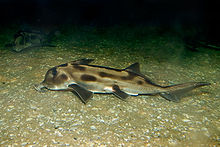Callorhinchidae
| Callorhinchidae | |
|---|---|
 |
|
| Callorhinchus milii | |
| Scientific classification | |
| Kingdom: | Animalia |
| Phylum: | Chordata |
| Class: | Chondrichthyes |
| Order: | Chimaeriformes |
| Family: |
Callorhinchidae Garman, 1901 |
| Genus: |
Callorhinchus Lacépède, 1798 |
| Species | |
C. callorynchus
C. capensis
C. milii
†C. torresi
The Callorhinchidae (sometimes spelled "Callorhynchidae"), or plough-nose chimaeras, are a family of marine fish containing one genus, Callorhinchus. They are similar in form and habits to other chimaeras, but are distinguished by the presence of an elongated, flexible, fleshy snout, with a vague resemblance to a ploughshare. The snout is used to probe the sea bottom in search of the invertebrates and small fishes on which it preys. The remainder of the body is flat and compressed, often described as elongated. The mouth is just under this snout and the eyes are located high on top of the head. The usual color is black or brown, and, often a mixture between the two. Phylogenetically, they are the oldest group of living jawed Chondrichthyes. They possess the same cartilaginous skeleton seen in sharks but are considered holocephali to distinguish them from the shark and ray categorization. Because of this, they provide a useful research organism for studying the early development of the jawed characteristic. Among the Chondrichthyes genome, Callorhinchus has the smallest genome. Because of this, it has been proposed to be used for entire genome sequencing to represent the cartilaginous fish class. They are considered to resemble a cross between a shark and a ray or skate, but can be distinguished from sharks because they possess an operculum over their gill slits. Additionally, their skin is smooth, not covered in tough scales, characteristic of the shark. While the shark's jaw is loosely attached to the skull, the Callorhinchidae family differ in that their jaws are fused to their skulls. Many classify the Callorhinchidae as a chimeric species due to their shared characteristics of both the sharks and rays. They are found in muddy and sandy substrates of the ocean bottom, where they filter feed, with small shellfish making up the bulk of their diet. They have broad flat teeth that have adapted for this type of eating habit, two pair that reside in the upper jaw and one pair in the lower jaw. In addition to its utilization for feeding, the trunk of the Callorhinchus fish can sense movement and electric fields, allowing them to locate their prey. They possess large pectoral fins, believed to aid in moving swiftly through the water. They also have two dorsal fins spaced widely apart, which help identify the species in the open ocean.
...
Wikipedia
